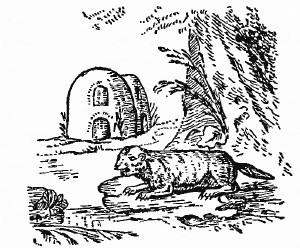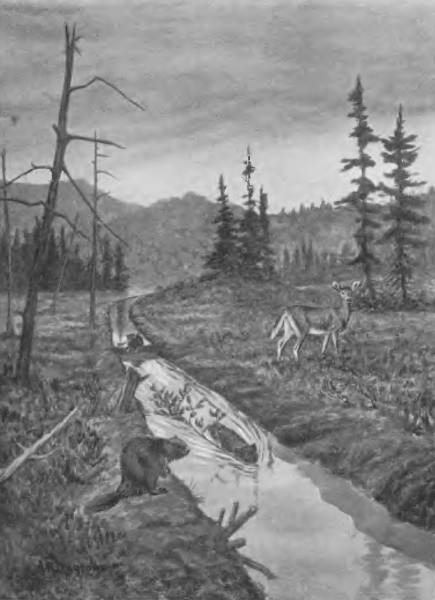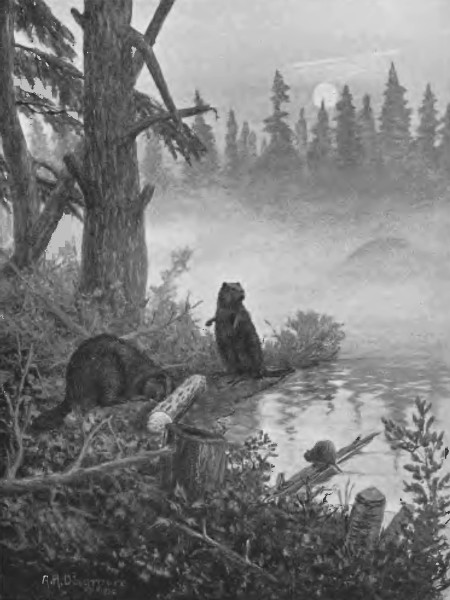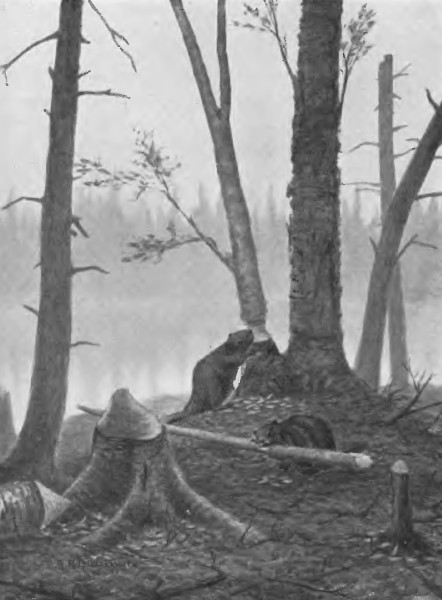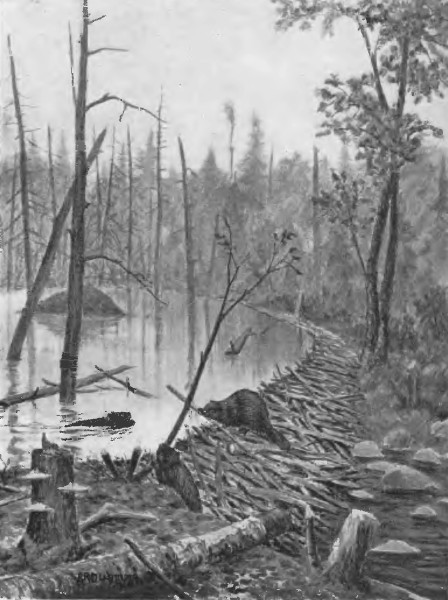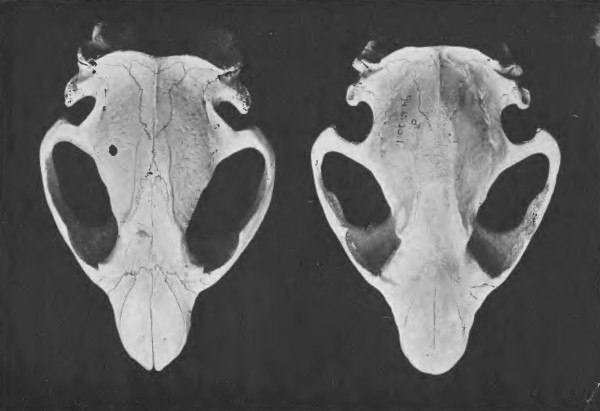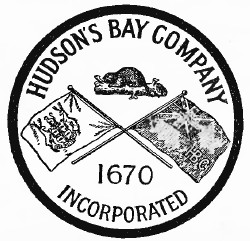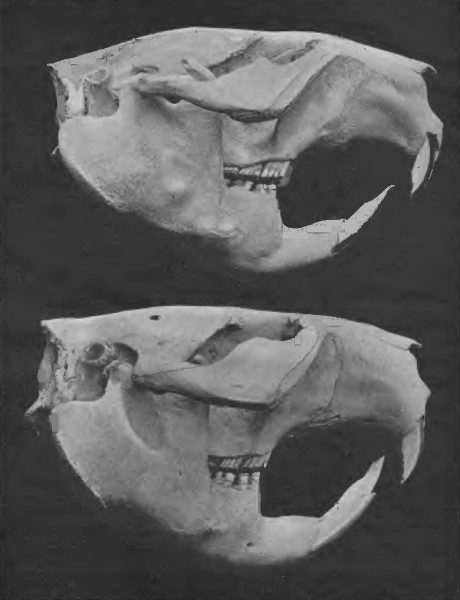| Web
and Book design, |
Click
Here to return to |
|
CHAPTER IV BEAVER
AND CANADIAN HISTORY-SHOWING SOMETHING OF THE PART PLAYED BY
THEM IN reading the earlier history of Canada, we find that from the very beginning, its development was inextricably interwoven with the life or, I should say, the death of the beaver. It lived on the beaver. It was opened up by the beaver, wars were waged through the competition for the skins of the little animals, the skins were the currency of the country, the clothing to some extent, and frequently did the earlier inhabitants depend on its meat for their food. In no country has an animal played such a conspicuous part. Going back to the first settlement of Canada, we find that the beaver held an important place in the life of the Indians. Their legends are full of allusions to the animals, and some tribes believed that the world was originally made by beaver, not the same kind that we have now, but by gigantic ones who were possessed of superhuman power. Some legends state that the beaver is a reincarnation of man, put back on earth to work for past offences, and early drawings show the beaver with men’s faces. Some of the Indians themselves claim descent from beaver, and there are many stories of intermarriage between beavers and Indian women, and of the women bearing beaver children. One of the most famous of the Indian ritualistic medicine bundles was known as the “beaver-bundle.” The owners of these curious assortments of objects were considered to have special powers, and were the weather men and almanac keepers. The origin of the bundles varies greatly according to the different tribes. One version only will be sufficient to give an idea of the legend, and is taken from Wissler and Duvall’s Blackfoot Mythology.1 BLOOD VERSION. “You say you have heard the story of Scabby-Round-Robe; but he did not first start the beaver-medicine, because it is said in the story that there was such a medicine before his time. The story I now tell you is about the origin of beaver-medicine. “Once there was a man and his wife camping alone on the shore of a small lake. This man was a great hunter, and had in his lodge skins of almost every kind of bird and animal. Among them was the skin of a white buffalo. As he was always hunting, his wife was often left alone. One day a beaver carne out of the water and made love to her. This went on for some time, until finally she went away with the beaver to his home in the water. Now when the man came home, he looked all about for his wife, but could not find her anywhere. As he was walking along the shore of the lake, he saw her trail going down into the water. Now he knew what had happened. He did not break camp, but continued his hunting. After four days, the woman came up out of the water and returned to her lodge. She was already heavy with child. When her husband returned that evening, he found her in her usual place, and she told him all that had occurred. “In the course of time the woman gave birth to a beaver. To keep it from dying she put it in a bowl of water, which she kept at the head of her bed. In the evening her husband came in as usual, and after a while, hearing something splashing in water, he said, ‘ What is that? ‘ Then the woman explained to him that she had given birth to a beaver. She brought him the bowl. He took out the little beaver, looked at it, and put it back. He said nothing. As time went on he became very fond of the young beaver and played with him every evening. “Now the beaver down in the water knew everything that was going on in the lodge. He knew that the man was kind to the young beaver, and so was not angry with him. He took pity on the man. Then the father of the young beaver resolved to give the man some of his medicine-songs in exchange for the skins of birds and animals the man had in his lodge. So one day, when the woman went down to the lake for water, the beaver came out and instructed her to request of her husband that whatever he [the beaver] should ask in his songs, that should be done. He also stated the time at which he would come to the lodge to be received by her husband. “At the appointed time the beaver came out of the lake and appeared before the lodge, but, before he entered, requested that the lodge be purified [a smudge]. Then he entered. They smoked. After ‘ a while the beaver began to sing a song, in which he asked for the skin of a certain bird. When he had finished, the man arose and gave the bird-skin to him. Then the beaver gave another song, in which he asked for the skin of another bird, which was given him. Thus he went on until he secured all the skins in the man’s lodge. In this way the man learned all the songs that belonged to the beaver-medicine and also the skins of the animals to which the songs belonged. "After this the man got together all the different kinds of bird and animal skins taken by the beaver, made them up into a bundle, and kept the beaver-medicine.” Beaver robes were supposed to have certain virtues and were used in many ceremonies, especially those in any way connected with death. Father Paul Le Jeune states that they were used “for what winding-sheets and shrouds are in France.” And in giving accounts of funeral rites he says: “When the friends have gazed upon the bodies to their satisfaction they cover them up with handsome beaver robes, quite new.” And again: “These bones are enclosed in caskets of bark covered with new beaver skins.” When the Iroquois, Onagan, delivered two captives over to Father Ragueneau, he said, lifting up a beaver robe, “Behold the standard that you shall plant upon your fort, when you shall see our canoes appear upon this great river; and, when we see this signal of your friendship we shall land with confidence at your ports.” As presents, nothing approached in value the beaver robe, not only on account of its actual worth, but it seemed to be a sort of emblem. The Jesuit priests, whose work in Canada during its early days was so very remarkable, realised thoroughly the sentimental value, both of these robes and the single skins. These were apparently always acceptable presents which carried with them some subtle meaning. When disturbances occurred they gave them as a seal of friendship. On one occasion when there had been trouble with the Iroquois we find that “in order to wipe out the blood, and implant joy in every breast, leaving no trace of sadness anywhere, the Father presented four beaver skins to the four Iroquois nations. One for each.” The intrinsic value of these skins was practically nothing, yet the giving of them meant a great deal. On another occasion, Father Ragueneau, in order to establish peace between two tribes made a gift of eight beavers to the Oneiotchronons at Three Rivers, “to exhort them to go to the chase without fear, and if they should meet the Algonquins they shall prepare a kettle, and give one another meat.”
In connection with the building of churches the beaver played an important part, and many edifices owe their existence to contributions of skins. “In the year 1645 Monsieur de Montmagny, the Governor, and the inhabitants gave twelve hundred and fifty beaver skins brought by the soldiers, who came from the Huron country, to have a church built at Kebec in honour of Our Lady of Peace.” The value of these skins was about 8,000 livres, and the size of the church (which was probably the original Parish Church of Quebec) was 30 by 100 feet. The churches were furnished indirectly by the beaver, for we find that “in the year 1642 Monsieur de l’Isle, lieutenant of Monsieur the Governor, gave a robe of beaver skins with which were purchased the two pieces of carpet that lie around the altar.” From the same source (The Jesuit Relations in Canada) there is given a pathetic account of the early Christianity (1659) of the Indians in which the beaver robes are mentioned. “A good Christian Algonkin (also in other places spelled Algonquin) woman named Cecile Kouekoueaté, falling sick in the midst of the woods and seeing herself in extremity without being able to confess, she believed that she might make up for this in some fashion with a present of beaver skins which she bequeathed to the Church at Three Rivers,” sending this by her kinsmen who came after her death to the priest. They spoke thus: “Black Gown (as they called the priests), listen to the voice of the dead and not to that of the living. It is not we who speak to thee; it is a departed woman who before dying enclosed her voice in this package. She charged it to declare to thee all her sins, as she herself could not do by word of mouth. Your handwriting enables you to speak to the absent; she intends to do so by these beaver skins what you do with your papers,” etc. A few years later, there is another account of a poor woman eighty years of age whose son had been slain, sending in her little offering of “six beaver skins in order to have prayers offered to God for his soul.”
It appears that the beaver skins caused serious difficulties to the priests, who were practically forced to use them as money and in many other ways. Apparently private persons were unable to send the skins to France, in fact they could not dispose of them for shipment except through the French company, which had such unlimited powers and which presumably did not pay anything like the price offered in Europe, so that the Jesuits were forced to lose heavily in the transaction. Father Le Jeune writes very strongly on this question, and I quote rather fully from him as his account has a direct bearing on the beaver and the way in which the use and sale of the skins crept in to all the dealings between France and Canada. He begins with the statement, “The 7th general congregation of our Society which absolutely forbids all kinds of commerce and business under any pretext whatever,” and further on, “Some of our Fathers send me word that we must not even look at from the corners of our eyes, or touch with ends of our fingers, the skins of any of these animals which are of great value here; what can be the cause of this advice?” He then relates how they have been slandered in France and says, “Peltry is not only the best thing and the easiest to make use of in this country, but it is also the coin of greatest value. And the best of it is that after it has been used as a covering2 it is found to be ready-made gold and silver. You know in France how much consideration is given to the style of a gown. Here all there is to do is to, cut it out of a beaver skin and the savage woman straightway sews it to her little child with a moose tendon, with admirable promptness. Who ever wishes to pay in this coin for the goods he buys here saves thereby the twenty-five per cent. that the market price gives them over that in France for the risk they rim upon the sea — and certainly it seems that commutative justice allows that, if what comes to us from France is dearer for having floated over the sea, what we have here is worth something for having been chased in the woods and over the snow, and for being the wealth of the Country, especially as those who are paid with this coin always find therein their reckoning and something more.” Twenty years later (1656-7) we find the situation has scarcely changed, as shown by the following extract from the Jesuit Relations: “That great council was held on the 24th of the month of July when all the Nation placed in the hands of Achiendasé (who is our Father Superior) the settlement of the difficulty between the Sonnontoueronnons and the Annieronnons, which was soon ended. They then, with manifestations of extraordinary good will, agreed that we should establish ourselves and reside in their country. Finally each one deposited his presents in the war kettle. We had so well displayed, arranged and disposed our presents, that they made a wonderful show. It will not be out of place to observe in passing that these presents consist entirely of porcelain collars, beads, arquebuses, powder and lead, coats, hatchets, kettles, and other similar articles. These are purchased from the Merchants with beaver skins, which are the money that they demand in payment for their wares. Now, if a Jesuit receives or collects some of the furs, to help pay the enormous expenses that have to be incurred in Missions so distant, to win these people to Jesus Christ and restore peace among them, it would be desirable that those very persons who ought to incur these expenses for the preservation of the country should, at least, not be the first to condemn the zeal of those Fathers, and in their tales to paint them blacker than their gowns. They write to us from France that they can no longer provide means for the heavy expenditure that we incur in these new undertakings. We devote to them our labours, our sweat, our blood and our lives.” In cases of crime the punishment, whether of white or red men, was invariably a fine payable in beaver skins. Even murder was pardoned with such payment. In one case a whole Huron village was called to account for murder and was compelled to pay the injured tribe “as many as sixty presents the least of which must be of the value of a new beaver robe.” Everything was valued by the standard of beaver skins. The profits resulting from the monopoly of the trade must have been enormous. One of the Jesuits in writing to a brother priest in 1638 says, “Our plates although of wood cost more than yours for they are valued at one beaver robe, which is a hundred francs.” Yet the Indians thought themselves well paid for the skins they brought as will be seen by their saying, “The beaver does everything perfectly well, it makes kettles, hatchets, swords, knives, bread; and in short makes everything. The English (probably meaning the white people) have no sense; they give us twenty knives like this for one beaver skin.” And the Indian (in 1657) was willing to pay one winter beaver skin for two pots of wine. As far back as 1647, the Tadousac trade, which was chiefly beaver skins, amounted to 40,000 livres profit, and in all to about 250,000 livres, and two years earlier 20,000 pounds of skins were carried away in two vessels. Internal warfare both between the various tribes of Indians and between them and the whites had a marked effect on the number of skins taken each year. In 1653, before the devastation of the Huron, it was said that “a hundred canoes used to come to trade, all laden with beaver skins and each year we had two or three hundred thousand livres worth. That was a fine revenue with which to satisfy all the people and defray the heavy expenses of the country,” and this in spite of the fact that the Iroquois did all they could to prevent the trade by incessant attacks on all who either trapped or carried the skins. In the above-mentioned year there is the following statement: “The country is not stripped of beaver; they form its gold mines and its wealth, which have only to be drawn upon in the lakes and streams, where the supply is great in proportion to the smallness of the draught upon it during these latter years due to the fear of being dispersed or captured by the Iroquois.” During the earlier years, the whites contented themselves with trading for skins, but gradually the desire for greater profits led them to indulge in trapping, and in 1656 I find almost the first notice of this in the following: “As nothing happened all winter long to mar our joy and as the atmosphere of peace had spread throughout the country especially in Montreal, the great number of beaver inhabiting the streams and neighbouring rivers attracted our Frenchmen thither as spring opened and the snow and ice melted. On all sides they hunted and waged war against these animals in good earnest, with pleasure and profit alike. A young surgeon in pursuit of his prey — laying his snares for the beaver in remote places where never had solitude seemed to him sweeter — a band of Onneiochronnon Iroquois, who had gone thither to hunt men, captured this hunter of animals.” This led to much trouble which fortunately did not end in bloodshed, as by diplomacy and the fairness of a chief of the Onnontachronon Iroquois named Sagochiendagnté, and the surgeon, after being badly frightened, returned to Montreal. It is curious that while the Indians killed and eat the beaver, esteeming it the greatest luxury of the country, that they should regard the animal as being in some senses sacred to such an extent that under no conditions might the bones be given to their dogs, but gathered with the utmost care and put into the pond for fear that the beaver spirit should be offended. So great was their solicitude for the proper treatment of the animals’ bones that even when they gave a beaver as a present, Father Le Jeune says, it was accompanied by the request that the recipient “should be most careful not to give the bones to the dogs, otherwise they believe they will take no more beavers.” When it was not convenient to put the remains in a pond or river, they burned them to avoid any possibility of their hunting being spoiled. Needless to say the pursuit of the beaver led to bloodshed in many instances, for not only did individuals commit murders, but tribal wars resulted in which horrible atrocities were committed. The white traders, in their eagerness to procure the skins from the Indians, supplied them with arms which were far more deadly than the primitive bows and arrows, with the inevitable result of increasing the casualties in the wars, and as one tribe was often more favoured than another in the way of arms, the ill feeling between them was fostered to a terrible extent. In 1659 the Dutch traders supplied the Algonquins with firearms, and this led to the practical annihilation of the Agnieronnons and others. But their triumph was not long-lived, for in the following year there is a statement that “the skin of the latter (beaver) is of so little value to them (the Algonquins), since the Iroquois has prevented its sale that they broil the beaver over the fire as is done with swine in France.” At this time the Algonquins settled in the Hudson Bay region, driven there apparently by the unceasing attacks made upon them by the Iroquois. So the beaver was to the Indian what gold has so often been to the white man — a rich gift of nature converted into a cause of bloodshed. Not only did this apply to the Indians, but through the jealousies of the rival trading companies the enmity of the tribes was incited against their rivals with terribly disastrous results. Still further was bloodshed caused by the innocent beaver, for the vessels carrying the valuable cargoes of furs from Canada were regarded as treasure ships, and we find mention of French vessels “richly laden with the spoils of the beaver of this country” being captured by “the English, who were waiting for it in the Channel.” From the very beginning the fur trade was stained with blood, and yet perhaps it might be said that the blood was shed for the good of the country. “The richly furred and highly prized skins formed the chief staple of Canadian commerce.” They paid its debts. Men grew rich on them. Vast fortunes such as the Astors’ were founded almost entirely on beaver skins. The Hudson Bay Company, one of the most powerful and successful companies that the world has ever known, owed its existence to furs, the most important being the beaver. This company was largely responsible for the opening up of Canada, the search for the skins taking their factors into even the most remote parts; in other words, civilisation — in a modified form perhaps — was carried into the wilderness in exchange for beaver pelts. In times of distress caused by famine or illness this great company rendered assistance to the improvident Indians, giving them food, medicine and clothing in exchange for their word that the results of the trapping should be taken by the Hudson Bay Company. Whether abuses ever crept into the management of the outlying districts I cannot say, but certainly on the whole their affairs were well conducted for the benefit of the Indian on whose welfare the Company so largely depended. Notwithstanding what has been said to the contrary the use of “fire-water” was certainly discountenanced. This in itself was a potent cause of peace. There is no doubt that many serious wars were averted by the diplomatic handling of what were often extremely difficult situations. (This is not a book on Canada, so that I scarcely feel justified in going too much into historical questions, but if the reader is interested in the subject he will find great pleasure in going through the accounts of the Hudson Bay Company, “The Relations of the Jesuits in Canada,” and other historic works relating to the subject.) As already stated the coin of the country was the beaver-skin; it was the unit of exchange or barter. If a man wanted a blanket or a knife or any article he was asked so many “beaver,” and though he did not always pay in actual skins they were the basis of all smaller transactions. Unfortunately it is impossible to estimate the number of beaver which were killed for use and sale. In 1854 no less than 509,000 skins were sold in London and Edinburgh, while Thompson Seton gives the average annual total “brought out by the American Fur Company and the Hudson’s Bay Company for the period between 1860 and 1870, when the fur trade was at its height, as, in round numbers, 150,000,” and he adds: “But the natives used as many good pelts as they sold and seldom saved the skins of those taken in summer, though they killed for food the whole year round, so that 500,000 per annum is more likely to represent the aggregate destruction by man.” How nearly correct this is it is impossible to say, but we do know that whatever the number that have been killed each year it has nearly always been greater than it should have been, a statement easily proved by the rapid disappearance of the animals throughout the greater part of their range. The following account written by Mr. R. MacFarlane, who was chief factor of the Hudson’s Bay Company, and published by the Smithsonian Institution (Washington) gives some interesting facts and figures: “If let alone, or not much disturbed by hunting, the beaver will rapidly increase in numbers. In proof of this statement, I would mention that many extensive tracts of country in which they had become scarce or had wholly or almost entirely disappeared (as a result of the keen and very costly rivalry in trade which had for many years existed between the Northwest Company of Montreal and the Hudson’s Bay Company of England previous to their coalition in 1821, it was uncertain for some time ‘which of them lost most money — neither of them gained money,’ while the general demoralization of Indians and whites was very lamentable) they afterwards recovered under the fostering policy of protection promptly inaugurated and intelligently pursued by the now united Fur Trading and Governing Corporation. For more than a decade subsequent to 1821 each beaver district in the chartered and licensed territories of the Hudson’s Bay Company was annually restricted to the collection of a certain fixed number of beaver, which course eventually proved of much benefit to all concerned. By this means the perpetuation of the beaver was insured in sections where reckless slaughter had almost exterminated it, while the resulting expansion in more forward localities naturally followed. With the view, however, of reconciling them to this enforced mode of preservation, the natives were strongly urged and encouraged to devote their best energies to the trapping of martens and other fur-bearing animals. After the beaver were known to have largely increased in numbers, and still sold well, the above rule was gradually relaxed; and as the wants of the Indians in those days were comparatively few, they never experienced any particular hardship from the limit thus imposed upon them in the general interest. It may be here mentioned that the Company never encouraged the hunting of beaver or any other pelt out of season. On the contrary they strictly prohibited the killing of beaver in summer, and would only reluctantly accept the skins of such animals as they were assured had been absolutely necessary for food purposes. “The introduction of nutria and silk in the manufacture of hats in the early forties of the last century struck a deadly blow at the value of beaver, the chief staple fur of Canada and the north-west for two centuries, from which it has not yet quite recovered. For nearly half a century thereafter, the prices annually obtained for pelts were some 60 and 70 per cent. below the average which had previously ruled. Since the Alaska fur seal, however, has come into ‘fashion’ very much better rates have been realised by the smaller quantities of beaver sold in recent years. With the view of obtaining better prices in England, as well as for its future increase in numbers, the Company naturally favoured a continuation of its beneficial policy of restriction; but owing to the then general abundance of beaver, and the advent of competition in the trade, this much desired course had to be gradually abandoned. For the twenty-five years, from 1853 to 1877, the Hudson’s Bay Company sold a total of nearly three million skins (2,965,389) of this important animal in the world’s fur mart — London. The yearly catch from 1853, with 55,456 pelts, to 87,013 in 1858 exhibited a steady increase. The year 1859, with 107,196 pelts, was, I believe, the first to reach and exceed the century mark since the union in 1821, but 1860 dropped to 91,459. While 1861 was only 926 skins below 1859, 1862 produced 115,580 pelts, 1863 produced 114,149, and 1864 produced 142,998, yet the last mentioned year’s sale was immediately followed by a decline of 24,750 pelts. The balance of the series from 1866 to 1877 varies between the minimum, 115,646 in 1877, and the maximum, 172,042 in 1867, certainly the highest and best since 1821, and probably one of, if not the most productive in the history of the Hudson’s Bay Company. An old writer of repute, however, writes that 175,000 beaver skins were collected by the ‘ancient concern’ in one year about the middle of the eighteenth century. It is possible that this large number may have comprised the country trade of two seasons. European wars were rather frequent and somewhat protracted in those days, while it is on record that one or two of the Company’s ships failed in making the annual round voyage between London and Hudson Bay. I think it is a matter of regret that neither of the two recent historians of the Hudson’s Bay Company, while throwing much light on the earlier and some of their later trade operations, have not also given us some definite statements of their yearly fur shipments and sales, which would have been generally appreciated. Mr. Beckles Willson has, however, given an interesting account of the Company’s first London public sale, which took place on January 24, 1672. On this occasion the 3,000 weight of beaver were put up in thirty lots, and fetched from 36 to 55 shillings (a pound probably). The other furs and peltries, bear, marten, and otter, &c., were reserved for a separate and subsequent auction, while previous receipts from the Bay had been disposed of by private treaty.
“This first official sale, as it subsequently proved, of a series of great transactions which for upward of two centuries have made London the centre of the world’s fur trade, excited the greatest interest, and both the Prince of Wales and the Duke of York, besides Dryden, the poet, were among the many spectators. Previous to the advent of Canadian traders from the East, the Indians of the surrounding country were wont to assemble in the spring at Lake Winnipeg to the number of perhaps 1,500, where also birch-bark canoes were built. Six hundred of these containing a thousand hunters, exclusive of women, came down annually to York factory with furs to trade. Beaver were very numerous in those days, and a great many were wasted in various ways, often as clothing and bedding. Not a few were hung on trees as native offerings upon the death of a child or near relation; occasionally the fur was burned off, and the beaver roasted whole for food banquets among the Indians. “He further states that in 1742, two large expeditions of natives from the interior came down to York and Churchill (Fort Prince of Wales). One of them had 200 packs of 100 skins each (20,000 beaver, probably from Lake Winnipeg country), and the other 300 packs of 100 each (30,000 beaver and 9,000 martens). This made a total of 50,000 beaver received from both ‘expeditions.’ I take it that these came from the Chipewyan Indians of the distant Athabasca and intervening country, reaching Churchill by way of the English and Churchill rivers. “Doctor Bryce, in his concise history, writes that so effective and successful were the operations of the Great Northwest Company of Montreal, that toward the end of the eighteenth century a single year’s trade produce was enormous, and comprised 106,000 beaver, 32,000 martens, 11,800 minks, 10,000 musquash, and 17,000 skins of other animals. Still, if we knew the total Hudson’s Bay Company’s catch for that year, I doubt if both returns of beaver would much exceed the total of 172,042 skins given in the London fur sale statement for 1867. From 1858 to 1884 the district of Athabasca contributed 445,014, or an average of 17,116 a year, to the Company’s London sales. The average for the self-same posts for the five outfits (1885 to 1889) is about 8,000; and with the ‘opposition’ trade added from 1890 to the spring of 1903, both will undoubtedly exhibit a further decline. From 1863 to 1883 Mackenzie River District exported a total of 183,216 beaver, giving an average of 11,822 a year. For the three years (1886, 1887, 1889) of which I hold data, it had fallen to 6,852, and is, I fear, very much lower at the present time. These are but samples of the general decrease in beaver receipts experienced at every trade competing point from Quebec to the North Pacific and from the international boundary to Hudson’s Bay and the north-western limit of its range in arctic America. “It is now well-known that for some years prior to the coalition in 1821, the annual catch of beaver was rapidly dwindling, and that in several sections it had been exterminated by reckless slaughter; another decade or two of similar trade competition would doubtless have led to its extinction, except for a time in retreats remote and difficult of access. We have had ample proof, however, by obtained results, of the beneficial operation of the wise and far-reaching policy adopted by Governor Sir George Simpson and the able and experienced fur-trade counsellors of the then united companies, for the due preservation of this valuable animal. For some years before and after the transfer of the country to Canada in 1870, the entire Peace River, together with many other streams and small ponds throughout the Territories, British Columbia, the Yukon, and the east were swarming with beaver; but this, unfortunately, is not the case to-day. From 1853 to 1877 inclusive, the average number of skins sold by the Hudson’s Bay Company in London was 118,615, as against their total catalogue sales of about 50,000 for 1897, 43,000 in 1900, 46,000 in 1902, and 49,190 for 1903. This is, without doubt, a bad showing for some of the later of the twenty-six years which have succeeded that statement. “Even with the addition thereto of the ‘opposition’ trade, in the very same locality, it is doubtful if the aggregate of both would greatly exceed one-half of this average. It is generally assumed that opposition’ or competition is the ‘life of trade’ in all branches of business; but in the opinion of many competent judges, the fur trade, from its very nature and the scope of its operations, is, or should be, one of the few essential exceptions to the rule. It is a matter of fact that the advent and continued presence of ‘free traders’ at a Company’s inland post has always had a more or less stimulating effect on the natives by inducing them to exert themselves to a larger degree than usual in the hunting of beaver and all other fur-bearing animals, but although at first and for some time all concerned appear to benefit by increased returns, yet the inevitable accompaniment of reckless and indiscriminate slaughter, sooner or later, adversely manifests itself. This has hitherto been the invariable experience at every assailed post or district in North America. “We all know how the bison or buffalo of the prairies of Canada and the United States has practically disappeared, although half a century ago it was reckoned by millions. The beaver has been Canada’s staple fur for centuries, and but for the Hudson’s Bay Company and its officers it would long ago have ceased to exist as a commercial asset. Unless further action speedily intervenes in the premises, however, the ultimate extermination of the Canadian beaver is merely a question of time. It has already disappeared for good from many sections in which it was formerly present. It is becoming very scarce in certain localities where it should receive immediate protection in the way of several legally-assured years of rest and full exemption from disturbance by hunters. In other districts, where it is generally but surely diminishing in numbers, its killing should be restricted on lines similar to those pursued by the Company for many years subsequent to 1821. Greater latitude might be accorded to hunting in now unknown and not easily accessible parts where it probably abounds; but except for food absolutely required no one should be permitted to trap or shoot beaver out of season. It is useless making rules and regulations, however, unless they be strictly enforced. The woodland buffalo is now receiving some well-deserved attention in this regard, and it is about time that the musk ox should be protected from indiscriminate slaughter solely for the sake of his head or hide: there should be a seasonable limit imposed upon hunters thereof. Neither should the mountain goat and sheep, the elk, and the valuable food animals — the moose and woodland caribou — be neglected in this connection. And although the Barren Ground reindeer is still abundant, yet the northern Indian should not be permitted to continue or resume their ancient vicious course of reckless and indiscriminate slaughter of them whenever the opportunity appeared.” In former times when the Indians had the almost exclusive trapping they were systematic in their work, and the number taken from each colony was seldom in excess of what would keep the numbers fairly stationary. When the white man entered the competition his one idea was to secure the largest possible crop of skins, utterly regardless of whether or not he killed the goose that laid the golden egg. The result was inevitable and the wasteful destruction reduced the crop to such a low level that from the animals’ entire range probably not more than 30,000 skins have been taken in any one year for some time past. At one time it was quite a question whether the beaver was not on the very verge of extermination. The passing of protective laws and the making of parks or reserves have, we hope, rendered this fear groundless, and the beaver that has done so much in the past to help in the development of Canada will find sanctuary in the land of its forefathers. So that the prediction made by Lydekker in 1894 in which he says “both the European and American beaver are doomed to extinction as wild animals at no very distant date” will not be fulfilled. 1 Published by the American Museum of Natural History in the series of Anthropological Papers. 1908. 2 The value of the skins for hatters’ purposes is increased by their having been used.
|

